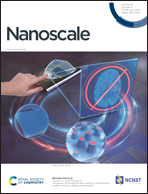Effect of coat-protein concentration on the self-assembly of bacteriophage MS2 capsids around RNA†
Abstract
Self-assembly is a vital part of the life cycle of certain icosahedral RNA viruses. Furthermore, the assembly process can be harnessed to make icosahedral virus-like particles (VLPs) from coat protein and RNA in vitro. Although much previous work has explored the effects of RNA–protein interactions on the assembly products, relatively little research has explored the effects of coat-protein concentration. We mix coat protein and RNA from bacteriophage MS2, and we use a combination of gel electrophoresis, dynamic light scattering, and transmission electron microscopy to investigate the assembly products. We show that with increasing coat-protein concentration, the products transition from well-formed MS2 VLPs to “monster” particles consisting of multiple partial capsids to RNA–protein condensates consisting of large networks of RNA and partially assembled capsids. We argue that the transition from well-formed to monster particles arises because the assembly follows a nucleation-and-growth pathway in which the nucleation rate depends sensitively on the coat-protein concentration, such that at high protein concentrations, multiple nuclei can form on each RNA strand. To understand the formation of the condensates, which occurs at even higher coat-protein concentrations, we use Monte Carlo simulations with coarse-grained models of capsomers and RNA. These simulations suggest that the formation of condensates occurs by the adsorption of protein to the RNA followed by the assembly of capsids. Multiple RNA molecules can become trapped when a capsid grows from capsomers attached to two different RNA molecules or when excess protein bridges together growing capsids on different RNA molecules. Our results provide insight into an important biophysical process and could inform design rules for making VLPs for various applications.



 Please wait while we load your content...
Please wait while we load your content...
